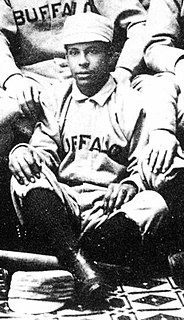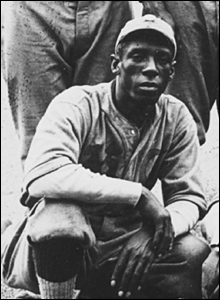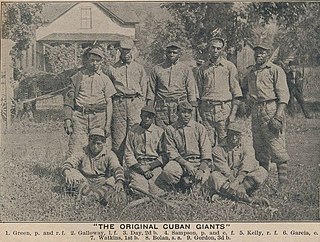Related Research Articles
The Negro leagues were United States professional baseball leagues comprising teams of African Americans and, to a lesser extent, Latin Americans. The term may be used broadly to include professional black teams outside the leagues and it may be used narrowly for the seven relatively successful leagues beginning in 1920 that are sometimes termed "Negro Major Leagues".
The color line, also known as the color barrier, in American baseball excluded players of black African descent from Major League Baseball and its affiliated Minor Leagues until 1947. Racial segregation in professional baseball was sometimes called a gentlemen's agreement, meaning a tacit understanding, as there was no written policy at the highest level of organized baseball, the major leagues. A high minor league's vote in 1887 against allowing new contracts with black players within its league sent a powerful signal that eventually led to the disappearance of blacks from the sport's other minor leagues later that century, including the low minors.

Ulysses Franklin Grant was an American baseball player in the 19th century. Early in his career, he was a star player in the International League, shortly before race-based restrictions were imposed that banned African-American players from organized baseball. Grant then became a pioneer in the early Negro leagues, starring for several of the top African-American teams of the late 19th and early 20th centuries. He is widely considered to have been the greatest African-American player of the 19th century. In 2006, Grant was elected to the National Baseball Hall of Fame.

José Colmenar del Valle Méndez was a Cuban right-handed pitcher and manager in baseball's Negro leagues. Born in Cárdenas, Matanzas, he died at age 43 in Havana. Known in Cuba as El Diamante Negro, he became a legend in his homeland. He was one of the first group of players elected to the Cuban Baseball Hall of Fame in 1939. He was elected to the National Baseball Hall of Fame and Museum in 2006.

The Cuban Giants were the first fully salaried African-American professional baseball club. The team was originally formed in 1885 at the Argyle Hotel, a summer resort in Babylon, New York. Initially an independent barnstorming team, they played games against opponents of all types: major and minor league clubs, semiprofessional teams, even college and amateur squads. They would go on to join various short-lived East Coast leagues, and in 1888 became the "World Colored Champions". Despite their name, no Cubans played on the team. The "Cubes" remained one of the premier Negro league teams for nearly 20 years, and served as a model that future black teams would emulate.
The Lincoln Giants were a Negro league baseball team based in New York City from 1911 through 1930.

Bud Fowler, born "John W. Jackson", was an American baseball player, manager, and club organizer. He is the earliest known African-American player in organized professional baseball. He was elected to the Baseball Hall of Fame in 2022.

The Cuban X-Giants were a professional Negro league baseball team that played from 1896 to 1906. Originally most of the players were former Cuban Giants, or ex-Giants. Like the Cuban Giants, the original players were not Cuban. Edward B. Lamar Jr. served as business manager for the team.
The National Colored Base Ball League, the National Colored League, or the League of Colored Baseball Clubs was the subsequent attempt, after the Southern League of Colored Base Ballists, to have a league consisting of all-black teams. It predated Rube Foster's Negro National League by over three decades.

George Washington Stovey is widely considered the best African-American baseball pitcher of the 19th century, but discrimination barred him from the majors, forcing him to play for various minor league teams throughout the 1880s and 1890s. Stovey was reportedly a target of the New York Giants to play in the majors in 1887.

King Solomon "Sol" White was an American professional baseball infielder, manager and executive, and one of the pioneers of the Negro leagues. An active sportswriter for many years, he wrote the first definitive history of black baseball in 1907. He was elected to the Baseball Hall of Fame in 2006.
The Philadelphia Giants were a Negro league baseball team that played from 1902 to 1911. From 1904 to 1909 they were one of the strongest teams in black baseball, winning five eastern championships in six years. The team was organized by Sol White, Walter Schlichter, and Harry Smith.
The 1887 St. Louis Browns season was the team's sixth season in St. Louis, Missouri, and the sixth season in the American Association. The Browns went 95–40 during the season and finished first in the American Association, winning their third pennant in a row. The team amassed 581 stolen bases, the most for any team whose records are recognized by Major League Baseball (MLB). In a postseason series, the Browns played the National League champion Detroit Wolverines, losing the series 10 games to 5.
Charles Grant Jr. was an American second baseman in Negro league baseball. During his 20-year career, he played for some of the best teams in the Negro leagues. Grant nearly crossed the baseball color line in 1901 when Major League Baseball manager John McGraw attempted to pass him off as a Native American named "Tokohama".

George L. Williams was an American baseball infielder who played on and managed predecessor teams to the Negro leagues. In 1885, he was recruited from a top amateur club in Philadelphia to play for the Cuban Giants. He served as the captain of the Cuban Giants from 1886 to 1889.
The Philadelphia Pythians was one of the earliest Negro league baseball clubs, founded in 1865. African-American leaders Jacob C. White Jr. and Octavius V. Catto established the team. The Pythians were composed of primarily business and middle class professionals from the surrounding areas of Washington, D.C., Philadelphia, and New York City. Just two years after the Civil War ended, in 1867, the Pennsylvania State Convention of Baseball, located in Harrisburg, denied the "Pythian Base Ball Club" out of Philadelphia. The team dissolved after Catto's death in 1871 and a new team formed under the Pythian name in the National Colored Base Ball League in 1887. The new team's first season went 4–1. However, due to financial troubles, the team folded after only one season.
Henry Walter "Slick" Schlichter was an American sports executive, sportswriter, and boxing referee.
The International League of Independent Professional Base Ball Clubs, also referred to as the International League, was a baseball league composed of a mix of white, Cuban and Negro league baseball teams in Philadelphia, Pennsylvania, as well as New Jersey and Wilmington, Delaware, during the summer of 1906. The league was planned to continue the following year, but never materialized for 1907.

The York Base Ball Club, nicknamed the Monarchs or Colored Monarchs, were a minor league baseball team that represented York, Pennsylvania, in the 1890 Eastern Interstate League. The team's roster was composed entirely of African Americans, hired from the two premier black professional clubs of the time, the Cuban Giants of Trenton, New Jersey, and the New York Gorhams. The Monarchs were in first place with a 39–16 record when the league disbanded in July 1890.
The Baltimore Lord Baltimores were a professional pre-Negro league baseball team based in Baltimore, Maryland in 1887. The Lord Baltimores played as charter members of the short–lived 1887 National Colored Base Ball League, hosting home games at Oriole Park.
References
- Lomax, Michael E. (2003). Black Baseball Entrepreneurs, 1860-1901: Operating By Any Means Necessary. Syracuse, New York: Syracuse University Press. ISBN 0-8156-2970-2.
- "The President Likes Base Ball". Philadelphia Inquirer. Philadelphia, Pennsylvania. August 16, 1891. Retrieved May 26, 2014.
- "Mr. Harrison at a Ball Game". Washington Post. Washington, D.C. August 16, 1891. Retrieved May 26, 2014.
- White, Sol (1995). Sol White's History of Colored Base Ball, with Other Documents of the Early Black Game, 1886-1936. Lincoln, Nebraska: University of Nebraska Press. ISBN 0-8032-4771-0.